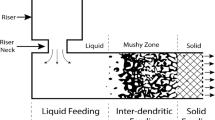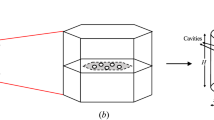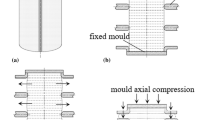Abstract
The void closure phenomenon of a large size rolled bar made from an as-cast low alloy steel ingot of grade AISI 4130 has been examined. The study involved FEM based simulation of hot rolling of a four metric ton ingot casting to a final product of 320 mm round corner square cross section with a reduction ratio of 4.3. The rolling process was varied at two process conditions. The process variables considered included initial cooling time of the ingot from soaking pit before rolling, rpm, reduction and pass schedule. The defects in the product at the two rolling conditions were experimentally evaluated using ultrasonic technique during hot rolling and compared with void fraction in the simulation. Higher initial time of cooling of the ingot before hot rolling, lower rpm, higher reduction and lesser number of tilts gave products with least core defect which justified simulation results. The study brought out at every stage the load and torque distribution, effective strain, stress triaxiality factor, void volume fraction and void healing hydrostatic integration parameter in the model which had enabled void closure.














Similar content being viewed by others
References
Keife H, and Stahlberg U, J Mech Work Technol 4 (1980) 133.
Stahlberg U, Keife H, Lundberg M, and Melander A, Swed J Mech Work Technol 4 (1980) 51.
Wallero A, J Mech Work Technol 12 (1985) 233.
Stahlberg U, J Mech Work Technol 13 (1986) 65.
Pietrzyk M, Kawalla R, and Pircher H, Steel Res 66 (1995) 526.
Wang A, Thomsona P, and Hodgsonb P, J Mater Process Technol 60 (1996) 95.
Nakasaki M, Takasu I, and Utsunomiya H, JMPT 177 (2006) 521.
Zhang X, Cui Z, Chen W, and Li Y, J Mater Process Technol 209 (2009) 1950.
Ji Y, Pak J, and Moon C, Int J Mod Phys B 23 (2009) 1591.
Kang S-H, Kim S-W, and Lee Y-S, Steel Res Int 81 (2010) 314.
Li S, Mingyue S, Hongwei L, and Li D, Acta Metall Sin 47 (2011) 946.
Simon S, Romans T, Recker D, Rosenstock D, Bambach M, and Hirt G, in Proceeding of First International Conference on Ingot Casting, Rolling and Forging, Steel Institute VDEh, Aachen, Germany (2012), p 1.
Jaouen O, Costes F, and Lanse P, in Proceeding of First International Conference on Ingot Casting, Rolling and Forging, Steel Institute VDEh, Aachen, Germany (2012), p 1.
Chen M, and Lin Y C, Int J Plast 49 (2013) 53.
Saby M, Bernacki M, and Bouchard P, in 11th International Conference on Technology of Plasticity (2014), p 19.
Joo S, Jung J, Chun M, Moon C, Lee S, and Kim H, Metall Mater Sci A 45 (2014) 4002.
Sobczak K, Dyja H, and Kawałek A, Arch Metall Mater 60 (2015).
Duan X, and Sheppard T, Model Simul Mater Sci Eng 9 (2001) 525.
Nalawade R S, Puranik A J, Balachandran G, Mahadik K N, and Balasubramanian V, Int J Mech Sci 77 (2013) 8.
Hadasik E, Jedrusik D, and Kawalla R, Acta Metall Slov 10 (2004) 271.
Byon S M, Kim S I, and Lee Y, Proc Inst Mech Eng Part B 218 (2004) 483.
Author information
Authors and Affiliations
Corresponding author
Rights and permissions
About this article
Cite this article
Nalawade, R.S., Patil, P.P., Balachandran, G. et al. Void Closure in a Large Cross Section Bars Hot Rolled from a Low Alloy Steel Ingot Casting. Trans Indian Inst Met 69, 1711–1721 (2016). https://doi.org/10.1007/s12666-016-0831-x
Received:
Accepted:
Published:
Issue Date:
DOI: https://doi.org/10.1007/s12666-016-0831-x




